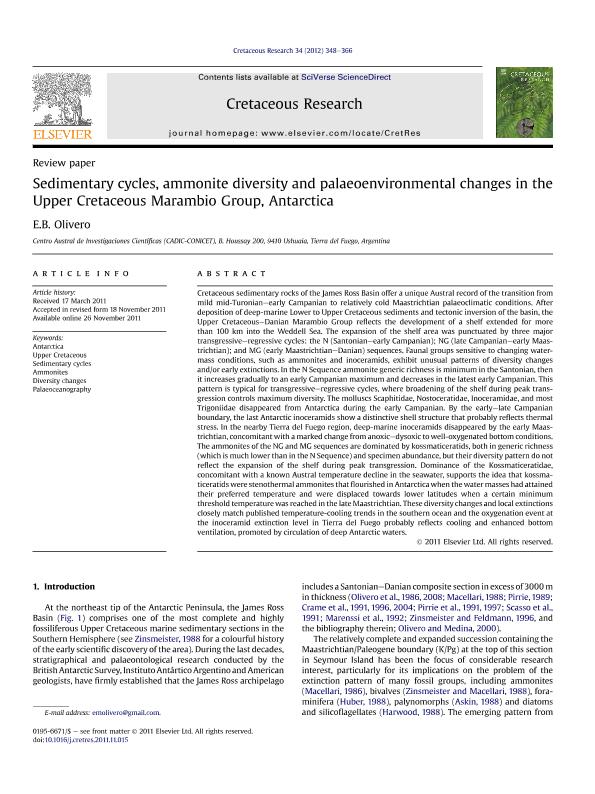Mostrar el registro sencillo del ítem
dc.contributor.author
Olivero, Eduardo Bernardo

dc.date.available
2016-04-28T20:13:25Z
dc.date.issued
2012-01
dc.identifier.citation
Olivero, Eduardo Bernardo; Sedimentary cycles, ammonite diversity and palaeoenvironmental changes in the Upper Cretaceous Marambio Group, Antarctica; Elsevier; Cretaceous Research; 34; 1-2012; 348-366
dc.identifier.issn
0195-6671
dc.identifier.uri
http://hdl.handle.net/11336/5434
dc.description.abstract
Cretaceous sedimentary rocks of the James Ross Basin offer a unique Austral record of the transition from mild mid-Turonian–early Campanian to relatively cold Maastrichtian palaeoclimatic conditions. After deposition of deep-marine Lower to Upper Cretaceous sediments and tectonic inversion of the basin, the Upper Cretaceous–Danian Marambio Group reflects the development of a shelf extended for more than 100 km into the Weddell Sea. The expansion of the shelf area was punctuated by three major transgressive–regressive cycles: the N (Santonian–early Campanian); NG (late Campanian–early Maastrichtian); and MG (early Maastrichtian–Danian) sequences. Faunal groups sensitive to changing water-mass conditions, such as ammonites and inoceramids, exhibit unusual patterns of diversity changes and/or early extinctions. In the N Sequence ammonite generic richness is minimum in the Santonian, then it increases gradually to an early Campanian maximum and decreases in the latest early Campanian. This pattern is typical for transgressive–regressive cycles, where broadening of the shelf during peak transgression controls maximum diversity. The molluscs Scaphitidae, Nostoceratidae, Inoceramidae, and most Trigoniidae disappeared from Antarctica during the early Campanian. By the early–late Campanian boundary, the last Antarctic inoceramids show a distinctive shell structure that probably reflects thermal stress. In the nearby Tierra del Fuego region, deep-marine inoceramids disappeared by the early Maastrichtian, concomitant with a marked change from anoxic–dysoxic to well-oxygenated bottom conditions. The ammonites of the NG and MG sequences are dominated by kossmaticeratids, both in generic richness (which is much lower than in the N Sequence) and specimen abundance, but their diversity pattern do not reflect the expansion of the shelf during peak transgression. Dominance of the Kossmaticeratidae, concomitant with a known Austral temperature decline in the seawater, supports the idea that kossmaticeratids were stenothermal ammonites that flourished in Antarctica when the water masses had attained their preferred temperature and were displaced towards lower latitudes when a certain minimum threshold temperature was reached in the late Maastrichtian. These diversity changes and local extinctions closely match published temperature-cooling trends in the southern ocean and the oxygenation event at the inoceramid extinction level in Tierra del Fuego probably reflects cooling and enhanced bottom ventilation, promoted by circulation of deep Antarctic waters.
dc.format
application/pdf
dc.language.iso
eng
dc.publisher
Elsevier

dc.rights
info:eu-repo/semantics/openAccess
dc.rights.uri
https://creativecommons.org/licenses/by-nc-nd/2.5/ar/
dc.subject
Antarctica
dc.subject
Upper Cretaceous
dc.subject
Sedimentary Cycles
dc.subject
Ammonites
dc.subject
Diversity Changes
dc.subject
Palaeoceanography
dc.subject.classification
Geología

dc.subject.classification
Ciencias de la Tierra y relacionadas con el Medio Ambiente

dc.subject.classification
CIENCIAS NATURALES Y EXACTAS

dc.title
Sedimentary cycles, ammonite diversity and palaeoenvironmental changes in the Upper Cretaceous Marambio Group, Antarctica
dc.type
info:eu-repo/semantics/article
dc.type
info:ar-repo/semantics/artículo
dc.type
info:eu-repo/semantics/publishedVersion
dc.date.updated
2016-05-06 15:52:43.262787-03
dc.journal.volume
34
dc.journal.pagination
348-366
dc.journal.pais
Países Bajos

dc.journal.ciudad
Amsterdam
dc.description.fil
Fil: Olivero, Eduardo Bernardo. Consejo Nacional de Investigaciones Científicas y Técnicas. Centro Austral de Investigaciones Científicas; Argentina
dc.journal.title
Cretaceous Research

dc.relation.alternativeid
info:eu-repo/semantics/altIdentifier/url/http://www.sciencedirect.com/science/article/pii/S0195667111001935
dc.relation.alternativeid
info:eu-repo/semantics/altIdentifier/doi/http://dx.doi.org/10.1016/j.cretres.2011.11.015
Archivos asociados
